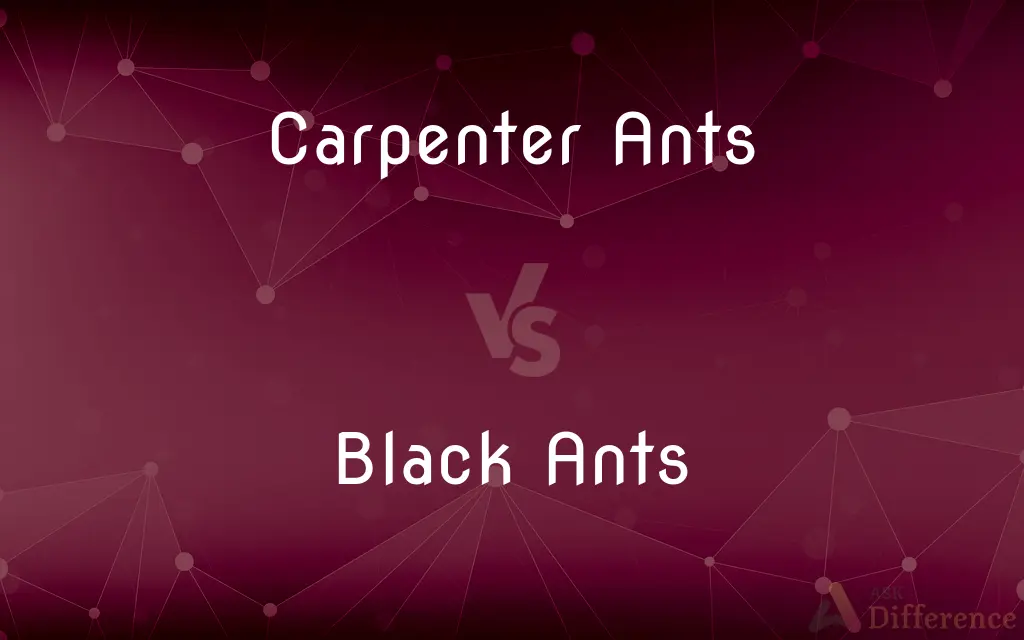Carpenter Ants vs. Black Ants — What's the Difference?
By Urooj Arif & Fiza Rafique — Published on February 26, 2024
Carpenter Ants are known for their wood-boring habits, creating nests within wood structures. Black Ants, a more generic term, can refer to various species, often characterized by their dark coloration and diverse habitats, including soil and under rocks.

Difference Between Carpenter Ants and Black Ants
Table of Contents
ADVERTISEMENT
Key Differences
Carpenter ants (Camponotus spp.) are large ants that excavate wood to create their nests, which can lead to structural damage in homes and buildings. They do not eat the wood but remove it to expand their living spaces. These ants are typically black but can also have reddish or yellowish coloration. Their nests are often found in moist or decaying wood, making areas with water damage particularly susceptible to carpenter ant infestations.
The term "black ants," however, is more generic and can encompass various ant species that share a common dark coloration. These ants vary significantly in size, behavior, and habitat preferences. Unlike carpenter ants, most black ants do not bore into wood but might nest in soil, under rocks, or within leaf litter. Their diet is diverse, ranging from plant material to other insects, and they are often seen foraging in long trails.
Carpenter ants are most active during the night, especially in the warmer months, and are often identified by the presence of frass (wood shavings mixed with ant waste) near their nests. In contrast, black ants can be active both day and night, depending on the species, and their presence is typically noted by their foraging trails and nest entrances on the ground.
Management of carpenter ant infestations often requires locating and eliminating nests, which can be challenging due to their preference for inaccessible wood areas. Black ant management, on the other hand, may involve reducing food sources, sealing entry points, and directly treating nests.
Understanding the specific behaviors and preferences of these ants is crucial for effective management, as control strategies can vary widely depending on the ant species and the extent of the infestation.
ADVERTISEMENT
Comparison Chart
Habitat
Moist or decaying wood
Soil, under rocks, leaf litter
Nesting Behavior
Excavate wood to create nests
Nest in soil or under objects
Appearance
Large, typically black, sometimes reddish
Generally smaller, dark-colored
Activity Patterns
Primarily nocturnal
Varies, can be nocturnal or diurnal
Diet
Protein and sugar sources, do not eat wood
Diverse, including plant and insect material
Signs of Infestation
Frass (wood shavings), structural damage
Soil mounds, visible foraging trails
Compare with Definitions
Carpenter Ants
Large ants that bore into wood to build nests.
Carpenter ants were found nesting in the water-damaged wooden beams of the house.
Black Ants
Diverse group of dark-colored ants.
The garden was teeming with black ants, busy tending to their underground nests.
Carpenter Ants
Prefer moist or decaying wood for nesting.
The carpenter ants established their nest in the damp wood near the leaky bathroom pipes.
Black Ants
Nest in a variety of habitats, including soil.
Black ants had formed intricate colonies beneath the rocks in the backyard.
Carpenter Ants
Active mainly at night, especially in warm weather.
The carpenter ants were most visible during their nocturnal foraging expeditions in the summer.
Black Ants
Diet includes plant material and insects.
The black ants were observed harvesting aphid honeydew on the garden plants.
Carpenter Ants
Recognizable by the frass they leave behind.
The pile of frass outside the wall crack indicated a carpenter ant infestation.
Black Ants
Can be active during the day or night, depending on the species.
The black ants were most active during the cool hours of the morning and late afternoon.
Carpenter Ants
Can cause structural damage to buildings.
The carpenter ants had hollowed out sections of the wooden deck, compromising its structural integrity.
Black Ants
Visible foraging trails and soil mounds.
The black ants' foraging trail led from the kitchen door to their nest entrance under the patio.
Common Curiosities
Are all black ants harmful to homes?
Not all black ants cause structural damage like carpenter ants. Most black ant species are harmless and simply forage for food.
What attracts carpenter ants to a house?
Carpenter ants are attracted to moist or decaying wood, often resulting from water leaks, poor ventilation, or previous damage.
How can you tell carpenter ants apart from black ants?
Carpenter ants are generally larger and may leave behind frass from their wood-boring activities, whereas black ants are more diverse in size and habitat and do not bore into wood.
Can black ants and carpenter ants coexist in the same area?
It's possible, but they have different nesting and foraging preferences, so they may not directly compete for resources.
What's the best way to manage a carpenter ant infestation?
Effective management involves eliminating moisture problems, removing infested wood, and potentially treating the area with insecticides designed for carpenter ants.
How do carpenter ants differ from termites?
Unlike termites, carpenter ants do not eat wood but remove it to build their nests, and they have a more defined waist and elbowed antennae compared to termites.
Are black ants beneficial to the environment?
Yes, black ants play important roles in ecosystems, such as aerating the soil, decomposing organic matter, and serving as a food source for other wildlife.
Can carpenter ant damage be repaired?
Yes, once the infestation is controlled, the damaged wood can be replaced or repaired, though significant structural damage may require professional restoration.
Can carpenter ants bite humans?
Carpenter ants can bite if threatened, but they are not aggressive towards humans and their bites are not harmful.
Do black ants pose any health risks?
While black ants are not typically considered a health risk, they can contaminate food sources and should be kept out of living spaces.
Share Your Discovery

Previous Comparison
Ceramic Brake Pads vs. Semi Metallic Brake Pads
Next Comparison
Punjabi vs. IndianAuthor Spotlight
Written by
Urooj ArifUrooj is a skilled content writer at Ask Difference, known for her exceptional ability to simplify complex topics into engaging and informative content. With a passion for research and a flair for clear, concise writing, she consistently delivers articles that resonate with our diverse audience.
Co-written by
Fiza RafiqueFiza Rafique is a skilled content writer at AskDifference.com, where she meticulously refines and enhances written pieces. Drawing from her vast editorial expertise, Fiza ensures clarity, accuracy, and precision in every article. Passionate about language, she continually seeks to elevate the quality of content for readers worldwide.
















































